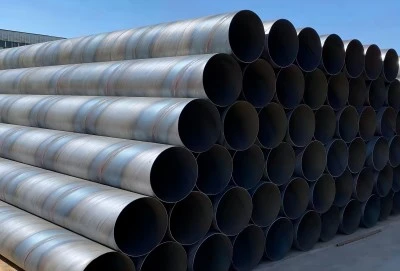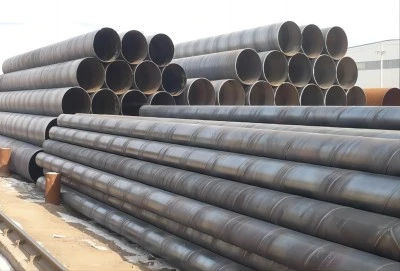In the world of steel pipe manufacturing, two common production methods stand out: Spiral Submerged Arc Welded (SSAW) and Electric Resistance Welded (ERW) pipes. Both types of pipes have their unique characteristics, advantages, and ideal applications. This article aims to explore the key structural differences between SSAW and ERW pipes, identify which applications are better suited for each type, and examine how pipe diameter and wall thickness capacity vary between these two processes. By understanding these distinctions, industry professionals can make informed decisions when selecting the most appropriate pipe for their specific needs.
|
|
|
Key Structural Differences Between SSAW and ERW Pipes
SSAW and ERW pipes differ significantly in their manufacturing processes and resulting structural characteristics. Let's delve into these key differences:
1. Manufacturing Process:
SSAW Pipes: SSAW steel pipes are produced using a spiral welding process. Steel strips or plates are helically coiled and welded along the spiral seam using submerged arc welding. This method allows for the production of large-diameter pipes with greater flexibility in terms of size and wall thickness.
ERW Pipes: ERW pipes are manufactured by rolling flat steel strips into a cylindrical shape and welding the longitudinal seam using high-frequency electric resistance welding. This process is typically faster and more suitable for smaller diameter pipes.
2. Weld Seam:
SSAW Pipes: The weld seam in SSAW pipes follows a spiral pattern along the length of the pipe. This spiral seam distributes stress more evenly across the pipe's surface, potentially enhancing its overall strength and pressure resistance.
ERW Pipes: ERW pipes feature a straight longitudinal weld seam running parallel to the pipe's axis. While this seam is generally strong, it may be more susceptible to longitudinal stress compared to the spiral seam of SSAW pipes.
3. Material Utilization:
SSAW Pipes: The spiral welding process allows for more efficient use of steel plates or coils, resulting in less material waste. This can be particularly advantageous when producing pipes with larger diameters.
ERW Pipes: The straight welding process in ERW pipe production may result in more material waste, especially for larger diameter pipes.
4. Dimensional Flexibility:
SSAW Pipes: SSAW steel pipes offer greater flexibility in terms of diameter and wall thickness. By adjusting the angle of the spiral weld, manufacturers can produce a wide range of pipe sizes using the same equipment.
ERW Pipes: ERW pipes typically have more limitations in terms of diameter and wall thickness, as the process is optimized for specific size ranges.
Understanding these structural differences is crucial for selecting the most appropriate pipe type for specific applications. The choice between SSAW and ERW pipes often depends on factors such as required diameter, wall thickness, pressure ratings, and intended use.
Applications Better Suited for SSAW Pipes Compared to ERW
While both SSAW and ERW pipes have their merits, certain applications are particularly well-suited for SSAW pipes. Let's explore some of these applications and understand why SSAW pipes are often preferred:
1. Large-Diameter Pipelines:
SSAW pipes excel in applications requiring large-diameter pipes, such as: - Oil and gas transmission pipelines - Water supply and distribution systems - Sewage and wastewater management
The spiral welding process allows for the efficient production of pipes with diameters ranging from 16 inches to over 100 inches, making SSAW pipes ideal for high-volume fluid transportation projects.
2. High-Pressure Applications:
Due to their spiral weld seam, SSAW pipes often demonstrate superior pressure resistance compared to ERW pipes. This makes them suitable for: - High-pressure oil and gas pipelines - Industrial process piping systems - Hydroelectric power plants
The even distribution of stress along the spiral seam contributes to the pipe's ability to withstand higher internal pressures.
3. Offshore and Marine Applications:
SSAW pipes are frequently used in offshore and marine environments, including: - Offshore oil and gas platforms - Subsea pipelines - Port and harbor construction
The ability to produce large-diameter pipes with thick walls makes SSAW pipes suitable for withstanding the harsh conditions and high pressures encountered in marine settings.
4. Structural Applications:
The strength and versatility of SSAW pipes make them ideal for various structural applications, such as: - Bridge construction - Piling and foundation work - Building columns and supports
The ability to customize pipe dimensions and wall thicknesses allows engineers to design structures that meet specific load-bearing requirements.
5. Long-Distance Transportation:
SSAW pipes are well-suited for long-distance transportation projects, including: - Cross-country pipelines - Municipal water supply networks - Industrial fluid transportation systems
The efficiency of the spiral welding process and the ability to produce longer pipe sections contribute to reduced installation time and costs for extensive pipeline projects.
While SSAW pipes excel in these applications, it's important to note that ERW pipes remain a popular choice for smaller diameter pipes and lower pressure systems. The selection between SSAW and ERW pipes should always be based on a thorough evaluation of project requirements, including factors such as pressure ratings, diameter needs, and cost considerations.
Pipe Diameter and Wall Thickness Capacity: SSAW vs ERW Processes
One of the most significant distinctions between SSAW and ERW pipe manufacturing processes lies in their capacity to produce pipes of varying diameters and wall thicknesses. Understanding these differences is crucial for project engineers and procurement specialists when selecting the most appropriate pipe type for their specific needs.
SSAW Pipe Diameter and Wall Thickness Capacity:
SSAW steel pipes offer a wide range of diameter and wall thickness options: - Diameter Range: SSAW pipes can typically be manufactured with outer diameters ranging from 16 inches (406 mm) to over 120 inches (3000 mm). Some advanced manufacturing facilities can produce even larger diameters. - Wall Thickness: SSAW pipes can accommodate wall thicknesses from about 6 mm to 25 mm or more, depending on the specific manufacturing capabilities and project requirements. - Diameter-to-Thickness Ratio: SSAW pipes can maintain a favorable diameter-to-thickness ratio, allowing for the production of large-diameter pipes with substantial wall thicknesses.
The flexibility in diameter and wall thickness is one of the primary advantages of SSAW pipes. This versatility allows manufacturers to meet a wide range of project specifications without the need for extensive retooling or equipment changes.
ERW Pipe Diameter and Wall Thickness Capacity:
ERW pipes generally have more limitations in terms of diameter and wall thickness: - Diameter Range: ERW pipes are typically produced with outer diameters ranging from 0.375 inches (9.5 mm) to about 24 inches (610 mm). Some advanced ERW mills can produce pipes up to 36 inches (914 mm) in diameter, but this is less common. - Wall Thickness: ERW pipes usually have wall thicknesses ranging from 0.028 inches (0.71 mm) to about 0.750 inches (19 mm). The maximum wall thickness is often limited by the power of the welding equipment and the material properties. - Diameter-to-Thickness Ratio: ERW pipes generally have limitations on the maximum diameter-to-thickness ratio, which can restrict their use in certain high-pressure or large-diameter applications.
The ERW process is particularly efficient for producing smaller diameter pipes with relatively thin walls, making it a cost-effective choice for many standard piping applications.
Comparative Analysis:
When comparing the two processes: 1. Large Diameter Capabilities: SSAW pipes have a clear advantage in producing large-diameter pipes, making them the preferred choice for major pipeline projects and large-scale fluid transportation systems. 2. Wall Thickness Range: While both processes can produce pipes with a range of wall thicknesses, SSAW pipes generally offer more flexibility, especially for larger diameters. 3. Production Efficiency: ERW pipes can be produced more quickly for smaller diameters, making them more cost-effective for high-volume production of standard-sized pipes. 4. Customization: SSAW pipes offer greater customization potential, allowing manufacturers to produce pipes with specific diameter and wall thickness combinations to meet unique project requirements.
The choice between SSAW and ERW pipes often comes down to the specific requirements of the project. For applications requiring large diameters or thick walls, SSAW pipes are typically the better option. However, for smaller diameter pipes used in standard applications, ERW pipes may offer a more cost-effective solution.
It's worth noting that advancements in manufacturing technology continue to push the boundaries of both SSAW and ERW pipe production. As such, consulting with experienced manufacturers and engineers is crucial to determine the most suitable pipe type for any given project.
SSAW Steel Pipe Manufacturer
As technology continues to advance, both SSAW and ERW pipe manufacturing processes are likely to see further improvements in terms of quality, efficiency, and capabilities. For project managers, engineers, and procurement specialists, staying informed about these advancements and understanding the strengths of each pipe type is crucial for making optimal decisions in pipe selection.
Longma Group, as a premier manufacturer of high-quality SSAW steel pipes, offers a wide range of products that meet international standards such as API 5L, ASTM A53, ASTM A500, ASTM A252, and ASTM A795. Our SSAW pipes are available in outer diameters ranging from 8 inches to 120 inches, with wall thicknesses from SCH10 to SCH160, catering to diverse project requirements. We also provide various packing methods, including bundling, wooden boxes, and wooden pallets, to ensure safe and secure delivery. If you need SSAW pipes or want to learn more about our products and how they can benefit your specific project, please don't hesitate to reach out to us at info@longma-group.com. Our team is dedicated to providing excellent products and services tailored to your needs.














